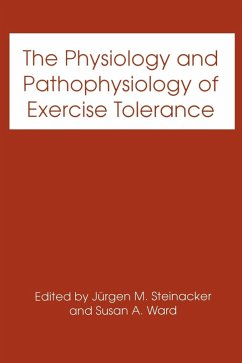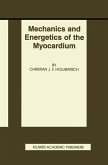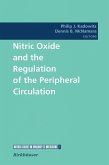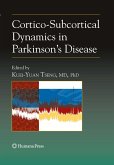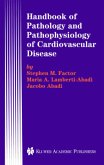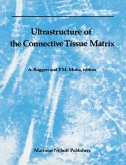Steinacker
The Physiology and Pathophysiology of Exercise Tolerance
Herausgegeben:Steinacker, Jürgen M.; Ward, Susan A.
Schade – dieser Artikel ist leider ausverkauft. Sobald wir wissen, ob und wann der Artikel wieder verfügbar ist, informieren wir Sie an dieser Stelle.
Steinacker
The Physiology and Pathophysiology of Exercise Tolerance
Herausgegeben:Steinacker, Jürgen M.; Ward, Susan A.
- Gebundenes Buch
- Merkliste
- Auf die Merkliste
- Bewerten Bewerten
- Teilen
- Produkt teilen
- Produkterinnerung
- Produkterinnerung
Proceedings of an international symposium, held in Ulm, Germany, September 21-24, 1994
Andere Kunden interessierten sich auch für
![Mechanics and Energetics of the Myocardium Mechanics and Energetics of the Myocardium]() Christian HolubarschMechanics and Energetics of the Myocardium121,99 €
Christian HolubarschMechanics and Energetics of the Myocardium121,99 €![Nitric Oxide and the Regulation of the Peripheral Circulation Nitric Oxide and the Regulation of the Peripheral Circulation]() Dennis B McNamaraNitric Oxide and the Regulation of the Peripheral Circulation92,99 €
Dennis B McNamaraNitric Oxide and the Regulation of the Peripheral Circulation92,99 €![Cortico-Subcortical Dynamics in Parkinson's Disease Cortico-Subcortical Dynamics in Parkinson's Disease]() Cortico-Subcortical Dynamics in Parkinson's Disease85,99 €
Cortico-Subcortical Dynamics in Parkinson's Disease85,99 €![Handbook of Pathology and Pathophysiology of Cardiovascular Disease Handbook of Pathology and Pathophysiology of Cardiovascular Disease]() Stephen M. FactorHandbook of Pathology and Pathophysiology of Cardiovascular Disease169,99 €
Stephen M. FactorHandbook of Pathology and Pathophysiology of Cardiovascular Disease169,99 €![Ultrastructure of the Connective Tissue Matrix Ultrastructure of the Connective Tissue Matrix]() Ultrastructure of the Connective Tissue Matrix63,99 €
Ultrastructure of the Connective Tissue Matrix63,99 €
Proceedings of an international symposium, held in Ulm, Germany, September 21-24, 1994
Produktdetails
- Produktdetails
- Verlag: Springer / Springer US / Springer, Berlin
- Artikelnr. des Verlages: 978-0-306-45492-9
- 1997.
- Seitenzahl: 333
- Erscheinungstermin: 31. Januar 1997
- Englisch
- Abmessung: 254mm x 178mm x 21mm
- Gewicht: 1950g
- ISBN-13: 9780306454929
- ISBN-10: 0306454920
- Artikelnr.: 24548985
- Herstellerkennzeichnung
- Libri GmbH
- Europaallee 1
- 36244 Bad Hersfeld
- gpsr@libri.de
- Verlag: Springer / Springer US / Springer, Berlin
- Artikelnr. des Verlages: 978-0-306-45492-9
- 1997.
- Seitenzahl: 333
- Erscheinungstermin: 31. Januar 1997
- Englisch
- Abmessung: 254mm x 178mm x 21mm
- Gewicht: 1950g
- ISBN-13: 9780306454929
- ISBN-10: 0306454920
- Artikelnr.: 24548985
- Herstellerkennzeichnung
- Libri GmbH
- Europaallee 1
- 36244 Bad Hersfeld
- gpsr@libri.de
1. Introduction.- 1. Greeting Address of the German Society of Cardiology in Honor of Professor Martin Stauch.- 2. Professor Martin Stauch: His Career.- 3. The Beginning of Applied Physiology and Sports Medicine in Ulm.- 4. Preventative Cardiology and Physical Activity: An Overview.- 2. The Physiological Basis of Muscular Fatigue.- 5. Mechanism of Fatigue in Small Muscle Groups.- 6. Factors Contributing to Enhanced Fatigue-Resistance in Low-Frequency Stimulated Muscle.- 7. Energy Metabolism and Muscle Fatigue during Exercise.- 8. Differences in Concentrically and Eccentrically Determined Local Muscle Endurance of the Shoulder Musculature with Different Training Status.- 9. Inactivity Alters Structural and Functional Properties of the Neuromuscular Junction.- 10. Effect of Passive and Active Recovery on PCr Kinetics.- 11. Phosphocreatine as an Energy Store and Energy Shuttle in Human Skeletal Muscles.- 3. Systemic Limitation to Maximum Exercise in Healthy Subjects.- 12. Domains of Aerobic Function and Their Limiting Parameters.- 13. Does Ventilation Ever Limit Human Performance?.- 14. Blood Flow Regulation during Exercise in Man.- 15. Thermoregulation and Fluid Balance as Possible Limiting Factors in Prolonged Exercise in Humans.- 16. Endocrine Regulation of Metabolism during Exercise.- 17. The Dynamics of Blood Flow Changes in Lower Limb Arteries during and following Exercise in Humans.- 18. Hypoxia and Anaemia Produce Equivalent Effects on Maximal Oxygen Consumption.- 19. Effect of Dry and Humid Heat on Plasma Catecholamines during Prolonged Light Exercise.- 20. Coordination of Breathing and Walking at Different Treadmill Speed and Slope Levels and Its Effects on Respiratory Rate and Minute Ventilation.- 21. Intracoronary Blockade of Nitric Oxide Synthetase Limits Coronary Vasodilation during Submaximal Exercise.- 22. Activation of Thrombocytes and the Hemostatic System during Maximal Cycle Exercise in Healthy Triathletes.- 23. Arterial O2 Desaturation during Supine Exercise in Highly Trained Cyclists.- 4. Pathophysiology of Exercise Intolerance.- 24. Exercise in Chronic Respiratory Disease.- 25. Exercise Physiology and the Immune System.- 26. Exercise Tolerance and Impairment of Sympathetic Nervous System Activity.- 27. Noninvasive Methods to Investigate Blood Supply to the Lower Extremities in Patients with Peripheral Arterial Occlusive Disease during Exercise.- 28. Determining the Lactate Threshold in Patients with Severe Chronic Obstructive Pulmonary Disease.- 29. Cardiovascular and Metabolic Responses to Exercise in Heart Transplanted Children.- 30. Death in Sports: Contrast between Team and Individual Sports.- 5. Sports-Specific Limitations to Exercise in Health and Disease.- 31. Physiological Limitations to Endurance Exercise.- 32. Cardiopulmonary and Metabolic Responses to Upper Body Exercise.- 33. Isokinetic Parameters of the Trunk as an Indicator of Physical Capacity.- 34. The Horserider's Spine during Exercise.- 35. Changes of Hormone Values during an Ultra Long Distance Run.- 36. Human Muscle Fibre Types and Mechanical Efficiency during Cycling.- 37. Sleep Apnea and Cardiovascular Risk Factors in Body Building and Abuse of Anabolic Steroids.- 38. Lactate Concentrations in Different Blood Compartments after 6-min Maximal Exercise in Well Trained Rowers.- 6. Enhancing Exercise Tolerance in Health and Disease.- 39. Can Amino Acids Influence Exercise Performance in Athletes?.- 40. Enhancing Exercise Tolerance in Patients with Lung Disease.- 41. Effects of Drugs on Exercise Tolerance in Patients with Cardiovascular Disease.-42. Training for the Enhancement of Exercise Tolerance in Patients with Left Ventricular Dysfunction.- 43. Clinical Dose-Response Effects of Exercise.- 44. Clinical Improvement of Skin Microcirculation in Patients with Chronic Venous Incompetence (CVI) by Physical Exercise Training.- 45. The Effect of Breathing Pattern during Respiratory Training on Cycling Endurance.- 46. The "Endurance Parameter Ratio" of the Power-Duration Curve and Race Variation Strategy for Distance Running.
1. Introduction.- 1. Greeting Address of the German Society of Cardiology in Honor of Professor Martin Stauch.- 2. Professor Martin Stauch: His Career.- 3. The Beginning of Applied Physiology and Sports Medicine in Ulm.- 4. Preventative Cardiology and Physical Activity: An Overview.- 2. The Physiological Basis of Muscular Fatigue.- 5. Mechanism of Fatigue in Small Muscle Groups.- 6. Factors Contributing to Enhanced Fatigue-Resistance in Low-Frequency Stimulated Muscle.- 7. Energy Metabolism and Muscle Fatigue during Exercise.- 8. Differences in Concentrically and Eccentrically Determined Local Muscle Endurance of the Shoulder Musculature with Different Training Status.- 9. Inactivity Alters Structural and Functional Properties of the Neuromuscular Junction.- 10. Effect of Passive and Active Recovery on PCr Kinetics.- 11. Phosphocreatine as an Energy Store and Energy Shuttle in Human Skeletal Muscles.- 3. Systemic Limitation to Maximum Exercise in Healthy Subjects.- 12. Domains of Aerobic Function and Their Limiting Parameters.- 13. Does Ventilation Ever Limit Human Performance?.- 14. Blood Flow Regulation during Exercise in Man.- 15. Thermoregulation and Fluid Balance as Possible Limiting Factors in Prolonged Exercise in Humans.- 16. Endocrine Regulation of Metabolism during Exercise.- 17. The Dynamics of Blood Flow Changes in Lower Limb Arteries during and following Exercise in Humans.- 18. Hypoxia and Anaemia Produce Equivalent Effects on Maximal Oxygen Consumption.- 19. Effect of Dry and Humid Heat on Plasma Catecholamines during Prolonged Light Exercise.- 20. Coordination of Breathing and Walking at Different Treadmill Speed and Slope Levels and Its Effects on Respiratory Rate and Minute Ventilation.- 21. Intracoronary Blockade of Nitric Oxide Synthetase Limits Coronary Vasodilation during Submaximal Exercise.- 22. Activation of Thrombocytes and the Hemostatic System during Maximal Cycle Exercise in Healthy Triathletes.- 23. Arterial O2 Desaturation during Supine Exercise in Highly Trained Cyclists.- 4. Pathophysiology of Exercise Intolerance.- 24. Exercise in Chronic Respiratory Disease.- 25. Exercise Physiology and the Immune System.- 26. Exercise Tolerance and Impairment of Sympathetic Nervous System Activity.- 27. Noninvasive Methods to Investigate Blood Supply to the Lower Extremities in Patients with Peripheral Arterial Occlusive Disease during Exercise.- 28. Determining the Lactate Threshold in Patients with Severe Chronic Obstructive Pulmonary Disease.- 29. Cardiovascular and Metabolic Responses to Exercise in Heart Transplanted Children.- 30. Death in Sports: Contrast between Team and Individual Sports.- 5. Sports-Specific Limitations to Exercise in Health and Disease.- 31. Physiological Limitations to Endurance Exercise.- 32. Cardiopulmonary and Metabolic Responses to Upper Body Exercise.- 33. Isokinetic Parameters of the Trunk as an Indicator of Physical Capacity.- 34. The Horserider's Spine during Exercise.- 35. Changes of Hormone Values during an Ultra Long Distance Run.- 36. Human Muscle Fibre Types and Mechanical Efficiency during Cycling.- 37. Sleep Apnea and Cardiovascular Risk Factors in Body Building and Abuse of Anabolic Steroids.- 38. Lactate Concentrations in Different Blood Compartments after 6-min Maximal Exercise in Well Trained Rowers.- 6. Enhancing Exercise Tolerance in Health and Disease.- 39. Can Amino Acids Influence Exercise Performance in Athletes?.- 40. Enhancing Exercise Tolerance in Patients with Lung Disease.- 41. Effects of Drugs on Exercise Tolerance in Patients with Cardiovascular Disease.-42. Training for the Enhancement of Exercise Tolerance in Patients with Left Ventricular Dysfunction.- 43. Clinical Dose-Response Effects of Exercise.- 44. Clinical Improvement of Skin Microcirculation in Patients with Chronic Venous Incompetence (CVI) by Physical Exercise Training.- 45. The Effect of Breathing Pattern during Respiratory Training on Cycling Endurance.- 46. The "Endurance Parameter Ratio" of the Power-Duration Curve and Race Variation Strategy for Distance Running.

